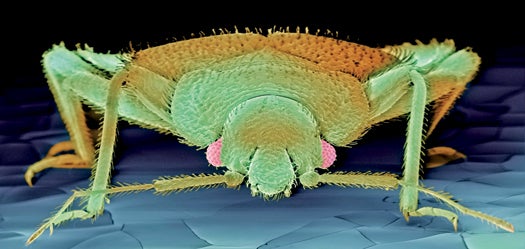New Tougher Bedbugs Are Harder Than Ever to Kill
The evolving bedbug is back and more infuriating than it's ever been before

After a half-century of relative inactivity in the U.S., bedbugs returned in the late 1990s. Nationwide, 95 percent of pest-control companies have treated an infestation in the past year. A decade ago, it was just 22 percent.
In the 1940s and ’50s, liberal use of DDT and other insecticides all but wiped out the pests. Scientists hypothesize that the few that survived proliferated—females can lay up to five eggs a day, and 500 during a lifetime—and passed along pesticide-resistant traits. Millions of bedbug generations later, scientists are finally zeroing in on how, exactly, bedbugs made their comeback.
Thicker Skin
Entomologist Dini Miller of Virginia Tech says bedbugs probably developed thicker, denser, waxlike exoskeletons, also called cuticles, that repel chemicals in pesticides. To test the hypothesis, her group is comparing cuticle-coding genes in both insecticide-resistant and susceptible bedbugs, as well as measuring their cuticle thickness and hydrocarbon content, which indicates how much wax is present. Miller says the results will be published next year.
Faster Metabolism
Contemporary bedbugs produce more P450 enzymes than their ancestors. The enzymes metabolize oily toxins like pyrethroids, the most common chemicals in pesticides, rendering them harmless. Entomologist Subba Reddy Palli of the University of Kentucky and his colleagues have identified at least 100 genes that code for P450s, and changes to any of them could account for the metabolism boost.
Chemical Blocking
Pyrethroids bind to and block sodium channels, paralyzing bugs. Palli’s studies show that 88 percent of bedbugs in the U.S. have mutated to block pyrethroids. “The future is to target something other than the sodium channel,” Palli says, “although eventually bedbugs will adapt again. It’s always a game of catch-up.”
Search and Destroy
When pesticides won’t work, physical removal is the only option. Find the bedbugs’ hiding spots with the help of a professional exterminator or trained dog. Bedbugs typically live where you sleep. Kill the pests by vacuuming them up, along with their shed skins and droppings. Throw all clothes, linens and any other fabrics into the dryer. Coming soon: an improved option for detection, the electronic dog nose.